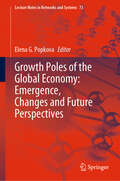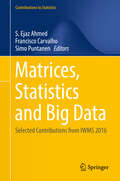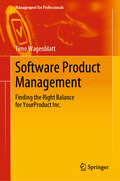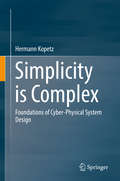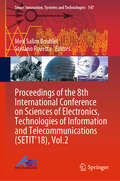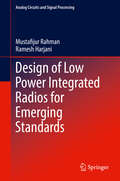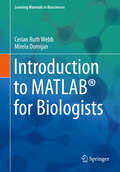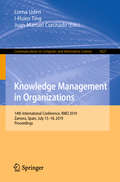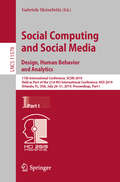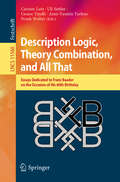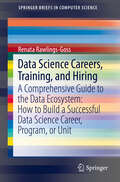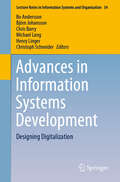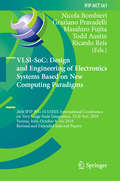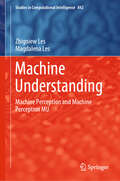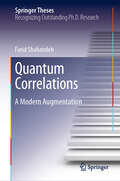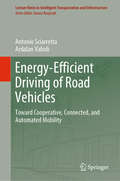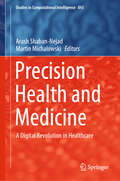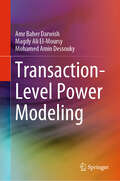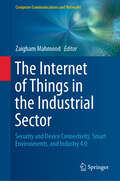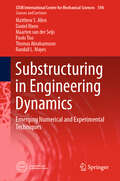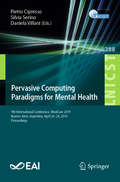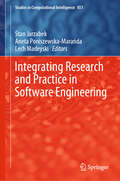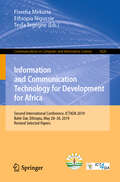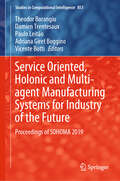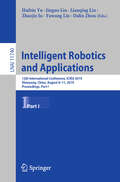- Table View
- List View
Growth Poles of the Global Economy: Emergence, Changes and Future Perspectives (Lecture Notes in Networks and Systems #73)
by Elena G. PopkovaThe book presents the best contributions from the international scientific conference “Growth Poles of the Global Economy: Emergence, Changes and Future,” which was organized by the Institute of Scientific Communications (Volgograd, Russia) together with the universities of Kyrgyzstan and various other cities in Russia. The 143 papers selected, focus on spatial and sectorial structures of the modern global economy according to the theory of growth poles. It is intended for representatives of the academic community: university and college staff developing study guides on socio-humanitarian disciplines in connection with the theory of growth poles, researchers, and undergraduates, masters, and postgraduates who are interested in the recent inventions and developments in the field. It is also a valuable resource for expert practitioners managing entrepreneurial structures in the existing and prospective growth poles of the global economy as well as those at international institutes that regulate growth poles.The first part of the book investigates the factors and conditions affecting the emergence of the growth poles of the modern global economy. The second part then discusses transformation processes in the traditional growth poles of the global economy under the influence of the technological progress. The third part examines how social factors affect the formation of new growth poles of the modern global economy. Lastly, the fourth part offers perspectives on the future growth of the global economy on the basis of the digital economy and Industry 4.0.
Matrices, Statistics and Big Data: Selected Contributions from IWMS 2016 (Contributions to Statistics)
by S. Ejaz Ahmed Francisco Carvalho Simo PuntanenThis volume features selected, refereed papers on various aspects of statistics, matrix theory and its applications to statistics, as well as related numerical linear algebra topics and numerical solution methods, which are relevant for problems arising in statistics and in big data. The contributions were originally presented at the 25th International Workshop on Matrices and Statistics (IWMS 2016), held in Funchal (Madeira), Portugal on June 6-9, 2016. The IWMS workshop series brings together statisticians, computer scientists, data scientists and mathematicians, helping them better understand each other’s tools, and fostering new collaborations at the interface of matrix theory and statistics.
Software Product Management: Finding the Right Balance for YourProduct Inc. (Management for Professionals)
by Timo WagenblattThis book is for product managers, product owners, product marketing managers, VPs and Heads of Product, CEOs, and start-up founders. In short, it serves anyone interested personally or professionally in software product management. You’ll learn how to plan, coordinate and execute all activities required for software product success. It enables you to find the right balance for delivering customer value and long-term product success.The book offers a comprehensive introduction for beginners as well as proven practices and a novel, holistic approach for experienced product managers. It provides much-needed clarity regarding the numerous tasks and responsibilities involved in the professional and successful management of software products. Readers can use this book as a reference book if they are interested in or have the urgent need to improve one of the following software product management dimensions: Product Viability, Product Development, Go-to-Market / Product Marketing, Software Demonstrations and Training, The Market / Your Customers, or Organizational Maturity.The book helps product people to maximize their impact and effectiveness. Whether you’re a seasoned practitioner, new to software product management, or just want to learn more about the best-of-all disciplines and advance your skills, this book introduces a novel and “business” tested approach to structure and orchestrate the vital dimensions of software product management. You will learn how to create focus and alignment on the things that matter for product success.The book describes a holistic framework to keep the details that matter for product success in balance, taking into consideration the limiting factors, strategies and responsibilities that determine the overall product yield potential. It explains how to leverage and adapt the framework with regard to aspects like product viability, product development, product marketing and software demonstrations and training, as well as more general aspects like markets, customers and organizational maturity.The book focuses on the unique challenges of software product managers or any related roles, whether you are a founder of a small to mid-sized software company or working in the complex ecosystems of large software enterprises or corporate IT departments.
Simplicity is Complex: Foundations of Cyber-Physical System Design
by Hermann KopetzThis book investigates the characteristics of simple versus complex systems, and what the properties of a cyber-physical system design are that contribute to an effective implementation and make the system understandable, simple to use, and easy to maintain. The targeted audience is engineers, managers and advanced students who are involved in the design of cyber-physical systems and are willing to spend some time outside the silo of their daily work in order to widen their background and appreciation for the pervasive problems of system complexity.In the past, design of a process-control system (now called cyber-physical systems) was more of an art than an engineering endeavor. The software technology of that time was concerned primarily with functional correctness and did not pay much attention to the temporal dimension of program execution, which is as important as functional correctness when a physical process must be controlled. In the ensuing years, many problems in the design of cyber-physical systems were simplified. But with an increase in the functional requirements and system size, the complexity problems have appeared again in a different disguise. A sound understanding of the complexity problem requires some insight in cognition, human problem solving, psychology, and parts of philosophy.This book presents the essence of the author’s thinking about complexity, accumulated over the past forty years.
Proceedings of the 8th International Conference on Sciences of Electronics, Technologies of Information and Telecommunications (Smart Innovation, Systems and Technologies #147)
by Med Salim Bouhlel Stefano RovettaThis two-volume book presents an unusually diverse selection of research papers, covering all major topics in the fields of information and communication technologies and related sciences. It provides a wide-angle snapshot of current themes in information and power engineering, pursuing a cross-disciplinary approach to do so. The book gathers revised contributions that were presented at the 2018 International Conference: Sciences of Electronics, Technologies of Information and Telecommunication (SETIT'18), held on 20–22 December 2018 in Hammamet, Tunisia. This eighth installment of the event attracted a wealth of submissions, and the papers presented here were selected by a committee of experts and underwent additional, painstaking revision. Topics covered include: · Information Processing · Human-Machine Interaction · Computer Science · Telecommunications and Networks · Signal Processing · Electronics · Image and Video This broad-scoped approach is becoming increasingly popular in scientific publishing. Its aim is to encourage scholars and professionals to overcome disciplinary barriers, as demanded by current trends in the industry and in the consumer market, which are rapidly leading toward a convergence of data-driven applications, computation, telecommunication, and energy awareness. Given its coverage, the book will benefit graduate students, researchers and practitioners who need to keep up with the latest technological advances.
Design of Low Power Integrated Radios for Emerging Standards (Analog Circuits and Signal Processing)
by Mustafijur Rahman Ramesh HarjaniThis book describes novel and disruptive architecture and circuit design techniques, toward the realization of low-power, standard-compliant radio architectures and silicon implementation of the circuits required for a variety of leading-edge applications. Readers will gain an understanding of the circuit level challenges that exist for low power radios, compatible with the IEEE 802.15.6 standard. The authors discuss current techniques to address some of these challenges, helping readers to understand the state-of-the-art, and to address the various, open research problems that exist with respect to realizing low power radios.Enables readers to face challenging bottleneck in low power radio design, with state-of-the-art, circuit-level design techniques;Provides readers with basic knowledge of circuits suitable for low power radio circuits compatible with the IEEE 802.15.6 standard;Discusses new and emerging architectures and circuit techniques, enabling applications such as body area networks and internet of things.
Introduction to MATLAB® for Biologists (Learning Materials in Biosciences)
by Cerian Ruth Webb Mirela DomijanThis textbook takes you from the very first time you open MATLAB® through to a position where you can comfortably integrate this computer language into your research or studies. The book will familiarise you with the MATLAB interface, show you how to use the program´s built-in functions and carefully guide you towards creating your own functions and scripts so that you can use MATLAB as a sophisticated tool to support your own research. A central aim of this book is to provide you with the core knowledge and skills required to become a confident MATLAB user so that you can find and make use of the many specialist functions and toolboxes that have been developed to support a wide range of biological applications. Examples presented within the book are selected to be relevant to biological scientists and they illustrate some of the many ways the program can be incorporated into, and used to enhance, your own research and studies. The textbook is a must-have for students and researchers in the biological sciences. It will also appeal to readers of all backgrounds who are looking for an introduction to MATLAB which is suitable for those with little or no experience of programming.
Knowledge Management in Organizations: 14th International Conference, KMO 2019, Zamora, Spain, July 15–18, 2019, Proceedings (Communications in Computer and Information Science #1027)
by Lorna Uden I-Hsien Ting Juan Manuel CorchadoThis book contains the refereed proceedings of the 14th International Conference on Knowledge Management in Organizations, KMO 2019, held in Zamora, Spain, in July 2019. The 46 papers accepted for KMO 2018 were selected from 109 submissions and are organized in topical sections on: knowledge management models and analysis; knowledge transfer and learning; knowledge and service innovation; knowledge creation; knowledge and organization; information systems and information science; data mining and intelligent science; social networks and social aspects of KM; big data and IoT; and new trends in IT.
Social Computing and Social Media. Design, Human Behavior and Analytics: 11th International Conference, SCSM 2019, Held as Part of the 21st HCI International Conference, HCII 2019, Orlando, FL, USA, July 26-31, 2019, Proceedings, Part I (Lecture Notes in Computer Science #11578)
by Gabriele MeiselwitzThis two-volume set LNCS 11578 and 11579 constitutes the refereed proceedings of the 11th International Conference on Social Computing and Social Media, SCSM 2019, held in July 2019 as part of HCI International 2019 in Orlando, FL, USA. HCII 2019 received a total of 5029 submissions, of which 1275 papers and 209 posters were accepted for publication after a careful reviewing process. The 81 papers presented in these two volumes are organized in topical sections named: Social Media Design and Development, Human Behaviour in Social Media, Social Network Analysis, Community Engagement and Social Participation, Computer Mediated Communication, Healthcare Communities, Social Media in Education, Digital Marketing and Consumer Experience.
Description Logic, Theory Combination, and All That: Essays Dedicated to Franz Baader on the Occasion of His 60th Birthday (Lecture Notes in Computer Science #11560)
by Carsten Lutz Uli Sattler Cesare Tinelli Anni-Yasmin Turhan Frank WolterThis Festschrift has been put together on the occasion of Franz Baader's 60th birthday to celebrate his fundamental and highly influential scientific contributions. The 30 papers in this volume cover several scientific areas that Franz Baader has been working on during the last three decades, including description logics, term rewriting, and the combination of decision procedures. We hope that readers will enjoy the articles gathered in Franz's honour and appreciate the breadth and depth of his favourite areas of computer science.
Data Science Careers, Training, and Hiring: A Comprehensive Guide to the Data Ecosystem: How to Build a Successful Data Science Career, Program, or Unit (SpringerBriefs in Computer Science)
by Renata Rawlings-GossThis book is an information packed overview of how to structure a data science career, a data science degree program, and how to hire a data science team, including resources and insights from the authors experience with national and international large-scale data projects as well as industry, academic and government partnerships, education, and workforce. Outlined here are tips and insights into navigating the data ecosystem as it currently stands, including career skills, current training programs, as well as practical hiring help and resources. Also, threaded through the book is the outline of a data ecosystem, as it could ultimately emerge, and how career seekers, training programs, and hiring managers can steer their careers, degree programs, and organizations to align with the broader future of data science. Instead of riding the current wave, the author ultimately seeks to help professionals, programs, and organizations alike prepare a sustainable plan for growth in this ever-changing world of data. The book is divided into three sections, the first “Building Data Careers”, is from the perspective of a potential career seeker interested in a career in data, the second “Building Data Programs” is from the perspective of a newly forming data science degree or training program, and the third “Building Data Talent and Workforce” is from the perspective of a Data and Analytics Hiring Manager. Each is a detailed introduction to the topic with practical steps and professional recommendations. The reason for presenting the book from different points of view is that, in the fast-paced data landscape, it is helpful to each group to more thoroughly understand the desires and challenges of the other. It will, for example, help the career seekers to understand best practices for hiring managers to better position themselves for jobs. It will be invaluable for data training programs to gain the perspective of career seekers, who they want to help and attract as students. Also, hiring managers will not only need data talent to hire, but workforce pipelines that can only come from partnerships with universities, data training programs, and educational experts. The interplay gives a broader perspective from which to build.
Advances in Information Systems Development: Designing Digitalization (Lecture Notes in Information Systems and Organisation #34)
by Bo Andersson Björn Johansson Chris Barry Michael Lang Henry Linger Christoph SchneiderThis volume features a collection of papers on emerging concepts, significant insights, novel approaches and ideas in information systems research. It examines advances in information systems development in general, and their impact on the development of new methods, tools and management. The book contains invited papers selected from the 27th International Conference on Information Systems Development (ISD) held in Lund, Sweden, August 22 - 24, 2018. The revised and expanded papers present research that focuses on methods, tools and management in information systems development. These issues are significant as they provide the basis for organizations to identify new markets, support innovative technology deployment, and enable mobile applications to detect, sense, interpret and respond to the environment.
VLSI-SoC: 26th IFIP WG 10.5/IEEE International Conference on Very Large Scale Integration, VLSI-SoC 2018, Verona, Italy, October 8–10, 2018, Revised and Extended Selected Papers (IFIP Advances in Information and Communication Technology #561)
by Ricardo Reis Masahiro Fujita Nicola Bombieri Graziano Pravadelli Todd AustinThis book contains extended and revised versions of the best papers presented at the 26th IFIP WG 10.5/IEEE International Conference on Very Large Scale Integration, VLSI-SoC 2018, held in Verona, Italy, in October 2018. The 13 full papers included in this volume were carefully reviewed and selected from the 27 papers (out of 106 submissions) presented at the conference. The papers discuss the latest academic and industrial results and developments as well as future trends in the field of System-on-Chip (SoC) design, considering the challenges of nano-scale, state-of-the-art and emerging manufacturing technologies. In particular they address cutting-edge research fields like heterogeneous, neuromorphic and brain-inspired, biologically-inspired, approximate computing systems.
Machine Understanding: Machine Perception and Machine Perception MU (Studies in Computational Intelligence #842)
by Zbigniew Les Magdalena LesThis unique book discusses machine understanding (MU). This new branch of classic machine perception research focuses on perception that leads to understanding and is based on the categories of sensory objects. In this approach the visual and non-visual knowledge, in the form of visual and non-visual concepts, is used in the complex reasoning process that leads to understanding. The book presents selected new concepts, such as perceptual transformations, within the machine understanding framework, and uses perceptual transformations to solve perceptual problems (visual intelligence tests) during understanding, where understanding is regarded as an ability to solve complex visual problems described in the authors’ previous books. Thanks to the uniqueness of the research topics covered, the book appeals to researchers from a wide range of disciplines, especially computer science, cognitive science and philosophy.
Quantum Correlations: A Modern Augmentation (Springer Theses)
by Farid ShahandehThe correlations between physical systems provide significant information about their collective behaviour – information that is used as a resource in many applications, e.g. communication protocols. However, when it comes to the exploitation of such correlations in the quantum world, identification of the associated ‘resource’ is extremely challenging and a matter of debate in the quantum community. This dissertation describes three key results on the identification, detection, and quantification of quantum correlations. It starts with an extensive and accessible introduction to the mathematical and physical grounds for the various definitions of quantum correlations. It subsequently focusses on introducing a novel unified picture of quantum correlations by taking a modern resource-theoretic position. The results show that this novel concept plays a crucial role in the performance of collaborative quantum computations that is not captured by the standard textbook approaches. Further, this new perspective provides a deeper understanding of the quantum-classical boundary and paves the way towards establishing a resource theory of quantum computations.
Energy-Efficient Driving of Road Vehicles: Toward Cooperative, Connected, and Automated Mobility (Lecture Notes in Intelligent Transportation and Infrastructure)
by Antonio Sciarretta Ardalan VahidiThis book elaborates the science and engineering basis for energy-efficient driving in conventional and autonomous cars. After covering the physics of energy-efficient motion in conventional, hybrid, and electric powertrains, the book chiefly focuses on the energy-saving potential of connected and automated vehicles. It reveals how being connected to other vehicles and the infrastructure enables the anticipation of upcoming driving-relevant factors, e.g. hills, curves, slow traffic, state of traffic signals, and movements of nearby vehicles. In turn, automation allows vehicles to adjust their motion more precisely in anticipation of upcoming events, and to save energy. Lastly, the energy-efficient motion of connected and automated vehicles could have a harmonizing effect on mixed traffic, leading to additional energy savings for neighboring vehicles. Building on classical methods of powertrain modeling, optimization, and optimal control, the book further develops the theory of energy-efficient driving. In addition, it presents numerous theoretical and applied case studies that highlight the real-world implications of the theory developed. The book is chiefly intended for undergraduate and graduate engineering students and industry practitioners with a background in mechanical, electrical, or automotive engineering, computer science or robotics.
Precision Health and Medicine: A Digital Revolution in Healthcare (Studies in Computational Intelligence #843)
by Arash Shaban-Nejad Martin MichalowskiThis book highlights the latest advances in the application of artificial intelligence to healthcare and medicine. It gathers selected papers presented at the 2019 Health Intelligence workshop, which was jointly held with the Association for the Advancement of Artificial Intelligence (AAAI) annual conference, and presents an overview of the central issues, challenges, and potential opportunities in the field, along with new research results. By addressing a wide range of practical applications, the book makes the emerging topics of digital health and precision medicine accessible to a broad readership. Further, it offers an essential source of information for scientists, researchers, students, industry professionals, national and international public health agencies, and NGOs interested in the theory and practice of digital and precision medicine and health, with an emphasis on risk factors in connection with disease prevention, diagnosis, and intervention.
Transaction-Level Power Modeling
by Amr Baher Darwish Magdy Ali El-Moursy Mohamed Amin DessoukyThis book describes for readers a methodology for dynamic power estimation, using Transaction Level Modeling (TLM). The methodology exploits the existing tools for RTL simulation, design synthesis and SystemC prototyping to provide fast and accurate power estimation using Transaction Level Power Modeling (TLPM). Readers will benefit from this innovative way of evaluating power on a high level of abstraction, at an early stage of the product life cycle, decreasing the number of the expensive design iterations.
The Internet of Things in the Industrial Sector: Security and Device Connectivity, Smart Environments, and Industry 4.0 (Computer Communications and Networks)
by Zaigham MahmoodThis book has a focus on the development and deployment of the Industrial Internet of Things (IIoT) paradigm, discussing frameworks, methodologies, benefits and limitations, as well as providing case studies of employing the IoT vision in the industrial domain. IIoT is becoming an attractive business reality for many organisations such as manufacturing, logistics, oil and gas, energy and other utilities, mining, aviation, and many more. The opportunities for this paradigm are huge, and according to one report, the IIoT market is predicted to reach $125 billion by 2021. The driving philosophy behind the IIoT is that smart machines are better than humans at accurately capturing, analysing and communicating real-time data. The underlying technologies include distributed computing, machine learning, artificial intelligence, and machine-to-machine communication, with a typical IIoT system consisting of intelligent systems (applications, controllers, sensors, and security mechanisms), data communication infrastructure (cloud computing, edge computing, etc.), data analytics (to support business intelligence and corporate decision making), and most importantly the human element. The promised benefits of the IIoT include enhanced safety, better reliability, smart metering, inventory management, equipment tracking, and facilities management. There are, however, numerous issues that are also becoming the focus of active research, such as concerns regarding service availability, data security, and device communication. Lack of ubiquitous interoperability between heterogeneous devices is also a major concern. This book intends to fill a gap in the IIoT literature by providing the scientific contributions and latest developments from researchers and practitioners of international repute, focusing on frameworks, methodologies, benefits, and inherent issues/barriers to connected environments, especially in industrial settings.The intended audience includes network specialists, hardware engineers, and security experts who wish to adopt newer approaches for device connectivity, IoT security, and sensor-based devices design. University level students, researchers and practitioners will also find the latest innovation in technology and newer approaches relevant to the IIoT from a distributed computing perspective.
Substructuring in Engineering Dynamics: Emerging Numerical and Experimental Techniques (CISM International Centre for Mechanical Sciences #594)
by Matthew S. Allen Daniel Rixen Maarten van der Seijs Paolo Tiso Thomas Abrahamsson Randall L. MayesThis book reviews the most common state-of-the art methods for substructuring and model reduction and presents a framework that encompasses most method, highlighting their similarities and differences. For example, popular methods such as Component Mode Synthesis, Hurty/Craig-Bampton, and the Rubin methods, which are popular within finite element software, are reviewed. Similarly, experimental-to-analytical substructuring methods such as impedance/frequency response based substructuring, modal substructuring and the transmission simulator method are presented. The overarching mathematical concepts are reviewed, as well as practical details needed to implement the methods. Various examples are presented to elucidate the methods, ranging from academic examples such as spring-mass systems, which serve to clarify the concepts, to real industrial case studies involving automotive and aerospace structures. The wealth of examples presented reveal both the potential and limitations of the methods.
Pervasive Computing Paradigms for Mental Health: 9th International Conference, MindCare 2019, Buenos Aires, Argentina, April 23–24, 2019, Proceedings (Lecture Notes of the Institute for Computer Sciences, Social Informatics and Telecommunications Engineering #288)
by Silvia Serino Pietro Cipresso Daniela VillaniThis book constitutes the refereed proceedings of the 9th International Conference on Pervasive Computing Paradigms for Mental Health, MindCare 2019, held in Buenos Aires, Argentina, in April 2019. The 22 papers presented were carefully reviewed and selected from 38 submissions and present new paradigms in mental healthcare, in parallel with compelling questions about how it is possible to promote and structure these changes to improve physical well-being.
Integrating Research and Practice in Software Engineering (Studies in Computational Intelligence #851)
by Stan Jarzabek Aneta Poniszewska-Marańda Lech MadeyskiIn this book, the authors highlight recent findings that hold the potential to improve software products or development processes; in addition, they help readers understand new concepts and technologies, and to see what it takes to migrate from old to new platforms. Some of the authors have spent most of their careers in industry, working at the frontiers of practice-based innovation, and are at the same time prominent researchers who have made significant academic contributions. Others work together with industry to test, in industrial settings, the methods they’ve developed in the lab. The choice of subject and authors represent the key elements of this book. Its respective chapters cover a wide range of topics, from cloud computing to agile development, applications of data science methods, re-engineering of aging applications into modern ones, and business and requirements engineering. Taken together, they offer a valuable asset for practitioners and researchers alike.
Information and Communication Technology for Development for Africa: Second International Conference, ICT4DA 2019, Bahir Dar, Ethiopia, May 28-30, 2019, Revised Selected Papers (Communications in Computer and Information Science #1026)
by Fisseha Mekuria Ethiopia Nigussie Tesfa TegegneThis book constitutes the proceedings of the Second International Conference on Information and Communication Technology for Development for Africa, ICT4DA 2019, held in Bahir Dar, Ethiopia, in May 2019.The 29 revised full papers presented were carefully reviewed and selected from 69 submissions. The papers address the impact of ICT in fostering economic development in Africa. In detail they cover the following topics: artificial intelligence and data science; wireless and mobile computing; and Natural Language Processing.
Service Oriented, Holonic and Multi-agent Manufacturing Systems for Industry of the Future: Proceedings of SOHOMA 2019 (Studies in Computational Intelligence #853)
by Theodor Borangiu Damien Trentesaux Paulo Leitão Adriana Giret Boggino Vicente BottiThis proceedings book presents selected peer-reviewed papers from the 9th International Workshop on ‘Service Oriented, Holonic and Multi-agent Manufacturing Systems for the Industry of the Future’ organized by Universitat Politècnica de València, Spain, and held on October 3–4, 2019. The SOHOMA 2019 Workshop aimed to foster innovation in the digital transformation of manufacturing and logistics by promoting new concepts and methods and solutions through service orientation in holonic and agent-based control with distributed intelligence. The book provides insights into the theme of the SOHOMA’19 Workshop – ‘Smart anything everywhere – the vertical and horizontal manufacturing integration, ’ addressing ‘Industry of the Future’ (IoF), a term used to describe the 4th industrial revolution initiated by a new generation of adaptive, fully connected, analytical and highly efficient robotized manufacturing systems. This global IoF model describes a new stage of manufacturing, that is fully automatized and uses advanced information, communication and control technologies such as industrial IoT, cyber-physical production systems, cloud manufacturing, resource virtualization, product intelligence, and digital twin, edge and fog computing. It presents the IoF interconnection of distributed manufacturing entities using a ‘system-of-systems’ approach, discussing new types of highly interconnected and self-organizing production resources in the entire value chain; and new types of intelligent decision-making support based on from real-time production data collected from resources, products and machine learning processing. This book is intended for researchers and engineers working in the manufacturing value chain, and specialists developing computer-based control and robotics solutions for the ‘Industry of the Future’. It is also a valuable resource for master’s and Ph.D. students in engineering sciences programs.
Intelligent Robotics and Applications: 12th International Conference, ICIRA 2019, Shenyang, China, August 8–11, 2019, Proceedings, Part I (Lecture Notes in Computer Science #11740)
by Haibin Yu Jinguo Liu Lianqing Liu Zhaojie Ju Yuwang Liu Dalin ZhouThe volume set LNAI 11740 until LNAI 11745 constitutes the proceedings of the 12th International Conference on Intelligent Robotics and Applications, ICIRA 2019, held in Shenyang, China, in August 2019. The total of 378 full and 25 short papers presented in these proceedings was carefully reviewed and selected from 522 submissions. The papers are organized in topical sections as follows:Part I: collective and social robots; human biomechanics and human-centered robotics; robotics for cell manipulation and characterization; field robots; compliant mechanisms; robotic grasping and manipulation with incomplete information and strong disturbance; human-centered robotics; development of high-performance joint drive for robots; modular robots and other mechatronic systems; compliant manipulation learning and control for lightweight robot. Part II: power-assisted system and control; bio-inspired wall climbing robot; underwater acoustic and optical signal processing for environmental cognition; piezoelectric actuators and micro-nano manipulations; robot vision and scene understanding; visual and motional learning in robotics; signal processing and underwater bionic robots; soft locomotion robot; teleoperation robot; autonomous control of unmanned aircraft systems. Part III: marine bio-inspired robotics and soft robotics: materials, mechanisms, modelling, and control; robot intelligence technologies and system integration; continuum mechanisms and robots; unmanned underwater vehicles; intelligent robots for environment detection or fine manipulation; parallel robotics; human-robot collaboration; swarm intelligence and multi-robot cooperation; adaptive and learning control system; wearable and assistive devices and robots for healthcare; nonlinear systems and control. Part IV: swarm intelligence unmanned system; computational intelligence inspired robot navigation and SLAM; fuzzy modelling for automation, control, and robotics; development of ultra-thin-film, flexible sensors, and tactile sensation; robotic technology for deep space exploration; wearable sensing based limb motor function rehabilitation; pattern recognition and machine learning; navigation/localization. Part V: robot legged locomotion; advanced measurement and machine vision system; man-machine interactions; fault detection, testing and diagnosis; estimation and identification; mobile robots and intelligent autonomous systems; robotic vision, recognition and reconstruction; robot mechanism and design. Part VI: robot motion analysis and planning; robot design, development and control; medical robot; robot intelligence, learning and linguistics; motion control; computer integrated manufacturing; robot cooperation; virtual and augmented reality; education in mechatronics engineering; robotic drilling and sampling technology; automotive systems; mechatronics in energy systems; human-robot interaction.
